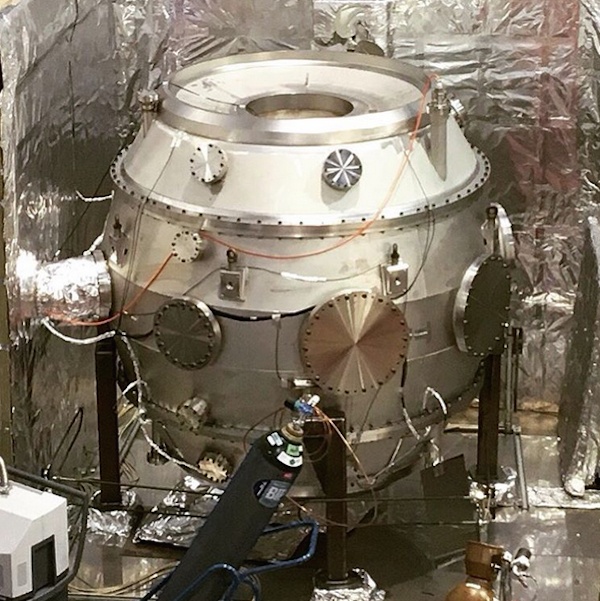Viewpoint
Melanie Windridge and David Kingham

Tokamak Energy’s contribution to putting fusion power into the grid by 2030: the ST40 prototype of a compact fusion reactor
The world is facing a deep decarbonisation challenge, and major organisations such as the Breakthrough Energy Coalition and the newly-announced Breakthrough Energy Ventures are seeking bold new technologies, like fusion, as the solution. Decarbonising all our energy requires a novel approach, but with engineers, scientists and private investors becoming increasingly serious about fusion, its potential is greater than ever.
Fusion researchers worldwide are developing technologies and materials for fusion power in the future. At Tokamak Energy, our aim is to put fusion power into the grid by 2030; we are pursuing the “spherical tokamak” route to achieve this using compact machines. Our theoretical and experimental research to date has shown that this can be a much faster route to fusion than more conventional large-scale tokamak devices.
Tokamak Energy grew out of the Culham Centre for Fusion Energy. It was established in 2010 with the objective of designing and developing small spherical tokamaks and compact fusion reactors. Spherical tokamak development was pioneered at Culham on the START and MAST tokamaks, which showed enhanced performance over the conventional doughnut shape. We are now building on this excellent science with a redirected focus on engineering, which enables us to further step up performance and progress towards achieving fusion.

An important element of our compact approach is the use of high temperature superconducting (HTS) magnets. In a tokamak, a magnetic field holds the plasma (an electrically-charged gas where the fusion reactions take place) away from the walls of the machine so that multi-million-degree temperatures can be achieved. HTS magnets can create higher magnetic fields than conventional (low temperature) superconductors whilst taking up less space, making them compatible with the more compact, squashed design of the spherical tokamak.
So HTS magnets allow for relatively small-size and low-power devices with high performance and widespread rapid commercial deployment opportunities. They also offer energy savings over conventional superconductors, which must be cooled to 4K (-269C). We plan to cool our HTS magnets to around 20K, though they remain superconducting up to 77K.
We have already built two experimental tokamaks and are constructing a third, the ST40. This is due to launch this Spring as part three of a five-stage plan to deliver fusion energy into the grid by 2030. It is designed to ultimately produce plasma temperatures of 100 million degrees (the right temperature range for controlled fusion on earth) though the near-term aim is to reach 15 million degrees (as hot as the centre of the sun) before the end of 2017. ST40 also aims to get within a factor of ten of energy breakeven conditions. To get even closer than that, we must then fine-tune the plasma density, temperature and confinement time.
The ST40 uses copper magnets rather than HTS so that we can build it relatively cheaply and quickly but demonstrate significant performance advances in the high-field, compact configuration. But for continuous reactor operation, rather than short experiments, superconducting magnets will have to be used. In parallel we are fast-track developing HTS magnet technology for use in our follow-up machine.
By 2019 the ST40 will demonstrate that fusion energy conditions are achievable in a small tokamak. At the same time we will unveil a large prototype HTS magnet suitable for a tokamak.
Our next tokamak device, using HTS magnets, will need to be significantly larger than ST40 – but still much smaller than huge tokamaks on the mainstream route to fusion, such as ITER, presently under construction in France. Using the knowledge acquired on ST40 we will build a reactor to demonstrate first electricity from fusion by 2025. This will then form the basis of a first-of-a-kind power plant module that will deliver electricity into the grid by 2030.
Our aims with the ST40 are bold and ambitious. Fusion is a huge challenge, but one that must be tackled if we are to deliver the essential decarbonisation of our energy supply. This will require massive investment, academic and industrial collaborations, an excellent supply chain, good management and many dedicated and creative engineers and scientists. Collaboration is crucial on the pathway to fusion energy as the multitude of complex challenges requires specialised knowledge and skill-sets.
At Tokamak Energy we are breaking the fusion development process down into a series of engineering challenges and raising successive investment on targets. We have received investment of £20m so far from L&G Capital, Oxford Instruments, the Institution of Mechanical Engineers, Rainbow Seed Fund and several others.
The future is bright for fusion. Private ventures are increasingly tackling challenges previously assumed to be the realm of governments and this will accelerate development. It allows smaller, agile companies such as ours to take different approaches to fusion and make new inroads into a field that has become large, political and cumbersome. As summarised nicely by Lord Rees of Ludlow, ex-President of the Royal Society, “the private sector now has a greater appetite for risk in scientific projects than Western governments.”
Tokamak Energy is treating the pursuit of fusion energy as an engineering challenge and business. We believe that with collaboration, dedication and investment, fusion will be a viable means of decarbonising global energy supply.
Dr David Kingham is Chief Executive, & Dr Melanie Windridge is Business Development Manager at Tokamak Energy, based at Culham in Oxfordshire










Water Sector Talent Exodus Could Cripple The Sector
Maybe if things are essential for the running of a country and we want to pay a fair price we should be running these utilities on a not for profit...